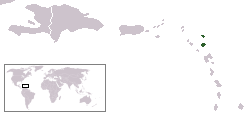 Antigua and Barbuda (pronounced /ænˌtiːgwə ænd bɑːɹˈbjuːdə/; Spanish for “ancient” and “bearded”) is a twin-island nation lying between the Caribbean Sea and the Atlantic Ocean. It consists of two major inhabited islands, Antigua and Barbuda, and a number of smaller islands (including Great Bird, Green, Guinea, Long, Maiden and York Islands). Separated by a few sea miles, the group is in the middle of the Leeward Islands part of the Lesser Antilles, roughly at 17 degrees north of the Equator. Being a part of the former British Empire has strongly influenced the country’s governance, language, and culture.
Antigua and Barbuda (pronounced /ænˌtiːgwə ænd bɑːɹˈbjuːdə/; Spanish for “ancient” and “bearded”) is a twin-island nation lying between the Caribbean Sea and the Atlantic Ocean. It consists of two major inhabited islands, Antigua and Barbuda, and a number of smaller islands (including Great Bird, Green, Guinea, Long, Maiden and York Islands). Separated by a few sea miles, the group is in the middle of the Leeward Islands part of the Lesser Antilles, roughly at 17 degrees north of the Equator. Being a part of the former British Empire has strongly influenced the country’s governance, language, and culture.
Christopher Columbus visited Antigua in 1493 and named it after a church in Sevilla, Spain. It was colonized by English settlers in 1632, who imported African slaves to grow tobacco and sugarcane. Barbuda was colonized by the English in 1678. In 1834 the islands’ slaves were emancipated. Antigua (with Barbuda) was part of the British colony of the Leeward Islands from 1871 until that colony was defederated in 1956. The islands achieved full independence in 1981.
The culture is predominantly British: For example, cricket is the national sport and Antigua has produced several famous cricket players including Sir Vivian Richards, Anderson “Andy” Roberts, and Richard “Richie” Richardson. Other popular sports include football, boat racing and surfing (the Antigua Sailing Week attracts locals and visitors from all over the world).
American popular culture and fashion also have a heavy influence. Most of the country’s media is made up of major United States networks. Antiguans pay close attention to American fashion trends, and major designer items are available at boutiques in St. John’s and elsewhere, although many Antiguans prefer to make a special shopping trip to St. Martin, North America, or San Juan in Puerto Rico.
Family and religion play an important roles in the lives of Antiguans. Most attend religious services on Sunday, although there is a growing number of Seventh-day Adventists who observe the Sabbath on Saturday.
Antigua has a relatively high GDP per capita in comparison to most other Caribbean nations. The economy experienced solid growth from 2003 to 2007, reaching over 12% in 2006, driven by a construction boom in hotels and housing associated with the Cricket World Cup. Growth dropped off in 2008 with the end of the boom. Tourism continues to dominate the economy, accounting for nearly 60% of GDP and 40% of investment. The dual-island nation’s agricultural production is focused on the domestic market and constrained by a limited water supply and a labor shortage stemming from the lure of higher wages in tourism and construction.
Manufacturing comprises enclave-type assembly for export with major products being bedding, handicrafts, and electronic components. Prospects for economic growth in the medium term will continue to depend on tourist arrivals from the US, Canada, and Europe and potential damages from natural disasters. Since taking office in 2004, the SPENCER government has adopted an ambitious fiscal reform program, and has been successful in reducing its public debt-to-GDP ratio from 120% to about 90%.
Notes from Wikipedia and Answers.com









